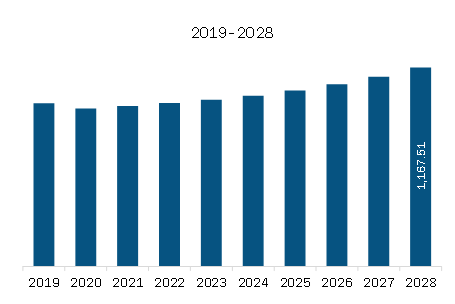The MEA HVAC chillers market is expected to grow from US$ 350.53 million in 2021 to US$ 404.35 million by 2028; it is estimated to grow at a CAGR of 2.1% from 2021 to 2028.
The UAE, Saudi Arabia, and South Africa are major economies in MEA. The improving economic conditions across the region coupled with urbanization has led to the growth in the industrial sector. There has been a rise in the construction of medical centers, malls, complexes, hotels, commercial buildings, and manufacturing facilities, which propels the demand for HVAC chillers. Urbanization has changed the lifestyle of the people and increased the inclination towards safety and security. Technological developments along with the modifications in government and organizational regulations for temperature control contributes towards the growth of the HVAC chiller market. Surging disposable income, temperature concerns, and spending on comfort and luxury are a few factors that drive the growth of the MEA HVAC chillers market.
Countries in MEA, especially South Africa, are highly affected due to the COVID-19 outbreak. The Middle East is an important oil-producing region in the world that comprises countries such as South Africa, Saudi Arabia, and the UAE. The COVID-19 pandemic has exposed the economies in the region to many additional challenges as most of countries faced a slack in the transportation operations, dip in goods demands, and disruptions in supply chain operations in FY 2020. Moreover, the UAE was estimated to be the largest market for HVAC chillers in the Middle East & Africa in FY 2020, according to the research study. The MEA market is majorly impacted owing to supply chain disruption. Further, as country boarders were closed, the supply chain of several industrial equipment and components were disturbed. This has led to a decline in revenue of the HVAC chiller manufacturers and distributors offering their products to different sectors, such as industrial, commercial, and residential applications. However, the restrictions are eased in 2021, and manufacturing of HVAC chillers gained traction as the demand for cooling devices across commercial and industrial facilities is growing.
With the new features and technologies, vendors can attract new customers and expand their footprints in emerging markets. This factor is likely to drive the MEA HVAC chillers market. The MEA HVAC chillers market is expected to grow at a good CAGR during the forecast period.
MEA HVAC Chillers Market Revenue and Forecast to 2028 (US$ Million)
- Sample PDF showcases the content structure and the nature of the information with qualitative and quantitative analysis.
- Request discounts available for Start-Ups & Universities
- Sample PDF showcases the content structure and the nature of the information with qualitative and quantitative analysis.
- Request discounts available for Start-Ups & Universities
MEA HVAC Chillers Market Segmentation
MEA HVAC Chillers Market By Technology
- Air-Cooled
- Water-Cooled
- Steam-Fired
MEA HVAC Chillers Market By Type
- Process Chillers
- Scroll Chillers
- Screw Chillers
- Centrifugal Chillers
- Absorption Chillers
MEA HVAC Chillers Market By Application
- Industrial
- Commercial
- Residential
MEA HVAC Chillers Market, by Country
- South Africa
- UAE
- Saudi Arabia
- Rest of MEA
MEA HVAC Chillers Market - Companies Mentioned
- AIREDALE INTERNATIONAL AIR CONDITIONING LTD.
- Carrier Global Corporation
- DAIKIN INDUSTRIES, Ltd.
- Johnson Controls, Inc.
- Kaltra
- LG Electronics
- Mitsubishi Electric Corporation
- SKM Air Conditioning
- Trane

Report Coverage
Revenue forecast, Company Analysis, Industry landscape, Growth factors, and Trends

Segment Covered
This text is related
to segments covered.

Regional Scope
North America, Europe, Asia Pacific, Middle East & Africa, South & Central America

Country Scope
This text is related
to country scope.
TABLE OF CONTENTS
1. Introduction
1.1 Study Scope
1.2 The Insight Partners Research Report Guidance
1.3 Market Segmentation
2. Key Takeaways
3. Research Methodology
3.1 Coverage
3.2 Secondary Research
3.3 Primary Research
4. MEA HVAC Chillers Market Landscape
4.1 Market Overview
4.2 MEA PEST Analysis
4.3 Ecosystem Analysis
4.4 Expert Opinions
5. MEA HVAC Chillers Market Key Market Dynamics
5.1 Market Drivers
5.1.1 Escalating Demand for HVAC Chillers from Several Industries
5.1.2 Surging Number of Data Centers
5.2 Market Restraints
5.2.1 Less Efficiency in Humid Environment and High Maintenance Cost
5.3 Market Opportunities
5.3.1 Surging Economic Growth in Developing Countries of the Region
5.4 Future Trends
5.4.1 Growing Development of IoT Enabled HVAC Chillers
5.5 Impact Analysis of Drivers and Restraints
6. HVAC Chillers Market MEA Analysis
6.1 MEA HVAC Chillers Market Overview
6.2 MEA HVAC Chillers Market Revenue and Forecast to 2028 (US$ Million)
7. MEA HVAC Chillers Market Analysis By Technology
7.1 Overview
7.2 MEA HVAC Chillers Market Breakdown, By Technology (2020 and 2028)
7.3 Air-Cooled
7.3.1 Overview
7.3.2 Air-Cooled: HVAC Chillers Market Revenue and Forecast to 2028 (US$ Million)
7.4 Water-Cooled
7.4.1 Overview
7.4.2 Water-Cooled: HVAC Chillers Market Revenue and Forecast to 2028 (US$ Million)
7.5 Steam-Fired
7.5.1 Overview
7.5.2 Steam-Fired: HVAC Chillers Market Revenue and Forecast to 2028 (US$ Million)
8. MEA HVAC Chillers Market Analysis By Type
8.1 Overview
8.2 MEA HVAC Chillers Market Breakdown, By Type (2020 and 2028)
8.3 Process Chillers
8.3.1 Overview
8.3.2 Process Chillers: HVAC Chillers Market Revenue and Forecast to 2028 (US$ Million)
8.4 Scroll Chillers
8.4.1 Overview
8.4.2 Scroll Chillers: HVAC Chillers Market Revenue and Forecast to 2028 (US$ Million)
8.5 Screw Chillers
8.5.1 Overview
8.5.2 Screw Chillers: HVAC Chillers Market Revenue and Forecast to 2028 (US$ Million)
8.6 Centrifugal Chillers
8.6.1 Overview
8.6.2 Centrifugal Chillers: HVAC Chillers Market Revenue and Forecast to 2028 (US$ Million)
8.7 Absorption Chillers
8.7.1 Overview
8.7.2 Absorption Chillers: HVAC Chillers Market Revenue and Forecast to 2028 (US$ Million)
9. MEA HVAC Chillers Market Analysis By Application
9.1 Overview
9.2 MEA HVAC Chillers Market Breakdown, By Application (2020 and 2028)
9.3 Industrial
9.3.1 Overview
9.3.2 Industrial: HVAC Chillers Market Revenue and Forecast to 2028 (US$ Million)
9.4 Commercial
9.4.1 Overview
9.4.2 Commercial: HVAC Chillers Market Revenue and Forecast to 2028 (US$ Million)
9.5 Residential
9.5.1 Overview
9.5.2 Residential: HVAC Chillers Market Revenue and Forecast to 2028 (US$ Million)
10. MEA HVAC Chillers Market Country Analysis
10.1 Overview
10.1.1 MEA: HVAC Chillers Market- by Key Country
10.1.1.1 South Africa: HVAC Chillers Market Revenue and Forecast to 2028 (US$ Million)
10.1.1.1.1 South Africa: HVAC Chillers Market- by Technology
10.1.1.1.2 South Africa: HVAC Chillers Market- By Type
10.1.1.1.3 South Africa: HVAC Chillers Market- By Application
10.1.1.2 UAE: HVAC Chillers Market Revenue and Forecast to 2028 (US$ Million)
10.1.1.2.1 UAE: HVAC Chillers Market- by Technology
10.1.1.2.2 UAE: HVAC Chillers Market- By Type
10.1.1.2.3 UAE: HVAC Chillers Market- By Application
10.1.1.3 Saudi Arabia: HVAC Chillers Market Revenue and Forecast to 2028 (US$ Million)
10.1.1.3.1 Saudi Arabia: HVAC Chillers Market- by Technology
10.1.1.3.2 Saudi Arabia: HVAC Chillers Market- By Type
10.1.1.3.3 Saudi Arabia: HVAC Chillers Market- By Application
10.1.1.4 Rest of MEA: HVAC Chillers Market Revenue and Forecast to 2028 (US$ Million)
10.1.1.4.1 Rest of MEA: HVAC Chillers Market- by Technology
10.1.1.4.2 Rest of MEA: HVAC Chillers Market- By Type
10.1.1.4.3 Rest of MEA: HVAC Chillers Market- By Application
11. Impact of COVID-19 Pandemic on MEA HVAC Chillers Market
11.1 MEA: Impact Assessment of COVID-19 Pandemic
12. Industry Landscape
12.1 Overview
12.2 New Development
13. Company Profiles
13.1 LG Electronics
13.1.1 Key Facts
13.1.2 Business Description
13.1.3 Products and Services
13.1.4 Financial Overview
13.1.5 SWOT Analysis
13.1.6 Key Developments
13.2 Mitsubishi Electric Corporation
13.2.1 Key Facts
13.2.2 Business Description
13.2.3 Products and Services
13.2.4 Financial Overview
13.2.5 SWOT Analysis
13.2.6 Key Developments
13.3 Carrier Global Corporation
13.3.1 Key Facts
13.3.2 Business Description
13.3.3 Products and Services
13.3.4 Financial Overview
13.3.5 SWOT Analysis
13.3.6 Key Developments
13.4 DAIKIN INDUSTRIES, Ltd.
13.4.1 Key Facts
13.4.2 Business Description
13.4.3 Products and Services
13.4.4 Financial Overview
13.4.5 SWOT Analysis
13.4.6 Key Developments
13.5 Trane
13.5.1 Key Facts
13.5.2 Business Description
13.5.3 Products and Services
13.5.4 Financial Overview
13.5.5 SWOT Analysis
13.5.6 Key Developments
13.6 Kaltra
13.6.1 Key Facts
13.6.2 Business Description
13.6.3 Products and Services
13.6.4 Financial Overview
13.6.5 SWOT Analysis
13.6.6 Key Developments
13.7 SKM Air Conditioning
13.7.1 Key Facts
13.7.2 Business Description
13.7.3 Products and Services
13.7.4 Financial Overview
13.7.5 SWOT Analysis
13.7.6 Key Developments
13.8 Johnson Controls, Inc.
13.8.1 Key Facts
13.8.2 Business Description
13.8.3 Products and Services
13.8.4 Financial Overview
13.8.5 SWOT Analysis
13.8.6 Key Developments
13.9 AIREDALE INTERNATIONAL AIR CONDITIONING LTD.
13.9.1 Key Facts
13.9.2 Business Description
13.9.3 Products and Services
13.9.4 Financial Overview
13.9.5 SWOT Analysis
13.9.6 Key Developments
14. Appendix
14.1 About The Insight Partners
14.2 Word Index
LIST OF TABLES
Table 1. MEA HVAC Chillers Market Revenue, and Forecast to 2028 (US$ Million)
Table 2. South Africa: HVAC Chillers Market- by Technology Revenue and Forecast to 2028 (US$ Million)
Table 3. South Africa: HVAC Chillers Market- By Type Revenue and Forecast to 2028 (US$ Million)
Table 4. South Africa: HVAC Chillers Market- By Application Revenue and Forecast to 2028 (US$ Million)
Table 5. UAE: HVAC Chillers Market- by Technology Revenue and Forecast to 2028 (US$ Million)
Table 6. UAE: HVAC Chillers Market- By Type Revenue and Forecast to 2028 (US$ Million)
Table 7. UAE: HVAC Chillers Market- By Application Revenue and Forecast to 2028 (US$ Million)
Table 8. Saudi Arabia: HVAC Chillers Market- by Technology Revenue and Forecast to 2028 (US$ Million)
Table 9. Saudi Arabia: HVAC Chillers Market- By Type Revenue and Forecast to 2028 (US$ Million)
Table 10. Saudi Arabia: HVAC Chillers Market- By Application Revenue and Forecast to 2028 (US$ Million)
Table 11. Rest of MEA: HVAC Chillers Market- by Technology Revenue and Forecast to 2028 (US$ Million)
Table 12. Rest of MEA: HVAC Chillers Market- By Type Revenue and Forecast to 2028 (US$ Million)
Table 13. Rest of MEA: HVAC Chillers Market- By Application Revenue and Forecast to 2028 (US$ Million)
Table 14. List of Abbreviation
LIST OF FIGURES
Figure 1. MEA HVAC Chillers Market Segmentation
Figure 2. MEA HVAC Chillers Market Segmentation By Country
Figure 3. MEA HVAC Chillers Market Overview
Figure 4. Air-Cooled HVAC Chillers Segment Held the Largest Market Share in 2020
Figure 5. Screw Chillers Segment Held the Largest Market Share in 2020
Figure 6. Industrial Segment Held the Largest Market Share in 2020
Figure 7. The UAE was the Largest Revenue Contributor in 2020
Figure 8. MEA PEST Analysis
Figure 9. MEA HVAC Chillers Market Ecosystem Analysis
Figure 10. Expert Opinions
Figure 11. MEA HVAC Chillers Market: Impact Analysis of Drivers and Restraints
Figure 12. MEA HVAC Chillers Market Revenue and Forecast to 2028 (US$ Million)
Figure 13. MEA HVAC Chillers Market Breakdown, By Technology (2020 and 2028)
Figure 14. MEA Air-Cooled: HVAC Chillers Market Revenue and Forecast to 2028 (US$ Million)
Figure 15. MEA Water-Cooled: HVAC Chillers Market Revenue and Forecast to 2028 (US$ Million)
Figure 16. MEA Steam-Fired: HVAC Chillers Market Revenue and Forecast to 2028 (US$ Million)
Figure 17. MEA HVAC Chillers Market Breakdown, By Type (2020 and 2028)
Figure 18. MEA Process Chillers: HVAC Chillers Market Revenue and Forecast to 2028 (US$ Million)
Figure 19. MEA Scroll Chillers: HVAC Chillers Market Revenue and Forecast to 2028 (US$ Million)
Figure 20. MEA Screw Chillers: HVAC Chillers Market Revenue and Forecast to 2028 (US$ Million)
Figure 21. MEA Centrifugal Chillers: HVAC Chillers Market Revenue and Forecast to 2028 (US$ Million)
Figure 22. MEA Absorption Chillers: HVAC Chillers Market Revenue and Forecast to 2028 (US$ Million)
Figure 23. MEA HVAC Chillers Market Breakdown, By Application (2020 and 2028)
Figure 24. MEA Industrial: HVAC Chillers Market Revenue and Forecast to 2028 (US$ Million)
Figure 25. MEA Commercial: HVAC Chillers Market Revenue and Forecast to 2028 (US$ Million)
Figure 26. MEA Residential: HVAC Chillers Market Revenue and Forecast to 2028 (US$ Million)
Figure 27. MEA: HVAC Chillers Market Revenue Overview, by Country (2020) (US$ Mn)
Figure 28. MEA: HVAC Chillers Market Revenue Share, By Key Country (2020 and 2028)
Figure 29. South Africa: HVAC Chillers Market Revenue and Forecast to 2028 (US$ Million)
Figure 30. UAE: HVAC Chillers Market Revenue and Forecast to 2028 (US$ Million)
Figure 31. Saudi Arabia: HVAC Chillers Market Revenue and Forecast to 2028 (US$ Million)
Figure 32. Rest of MEA: HVAC Chillers Market Revenue and Forecast to 2028 (US$ Million)
Figure 33. Impact of COVID-19 Pandemic in MEA Country Markets
1. AIREDALE INTERNATIONAL AIR CONDITIONING LTD.
2. Carrier Global Corporation
3. DAIKIN INDUSTRIES, Ltd.
4. Johnson Controls, Inc.
5. Kaltra
6. LG Electronics
7. Mitsubishi Electric Corporation
8. SKM Air Conditioning
9. Trane
The Insight Partners performs research in 4 major stages: Data Collection & Secondary Research, Primary Research, Data Analysis and Data Triangulation & Final Review.
- Data Collection and Secondary Research:
As a market research and consulting firm operating from a decade, we have published many reports and advised several clients across the globe. First step for any study will start with an assessment of currently available data and insights from existing reports. Further, historical and current market information is collected from Investor Presentations, Annual Reports, SEC Filings, etc., and other information related to company’s performance and market positioning are gathered from Paid Databases (Factiva, Hoovers, and Reuters) and various other publications available in public domain.
Several associations trade associates, technical forums, institutes, societies and organizations are accessed to gain technical as well as market related insights through their publications such as research papers, blogs and press releases related to the studies are referred to get cues about the market. Further, white papers, journals, magazines, and other news articles published in the last 3 years are scrutinized and analyzed to understand the current market trends.
- Primary Research:
The primarily interview analysis comprise of data obtained from industry participants interview and answers to survey questions gathered by in-house primary team.
For primary research, interviews are conducted with industry experts/CEOs/Marketing Managers/Sales Managers/VPs/Subject Matter Experts from both demand and supply side to get a 360-degree view of the market. The primary team conducts several interviews based on the complexity of the markets to understand the various market trends and dynamics which makes research more credible and precise.
A typical research interview fulfils the following functions:
- Provides first-hand information on the market size, market trends, growth trends, competitive landscape, and outlook
- Validates and strengthens in-house secondary research findings
- Develops the analysis team’s expertise and market understanding
Primary research involves email interactions and telephone interviews for each market, category, segment, and sub-segment across geographies. The participants who typically take part in such a process include, but are not limited to:
- Industry participants: VPs, business development managers, market intelligence managers and national sales managers
- Outside experts: Valuation experts, research analysts and key opinion leaders specializing in the electronics and semiconductor industry.
Below is the breakup of our primary respondents by company, designation, and region:

Once we receive the confirmation from primary research sources or primary respondents, we finalize the base year market estimation and forecast the data as per the macroeconomic and microeconomic factors assessed during data collection.
- Data Analysis:
Once data is validated through both secondary as well as primary respondents, we finalize the market estimations by hypothesis formulation and factor analysis at regional and country level.
- 3.1 Macro-Economic Factor Analysis:
We analyse macroeconomic indicators such the gross domestic product (GDP), increase in the demand for goods and services across industries, technological advancement, regional economic growth, governmental policies, the influence of COVID-19, PEST analysis, and other aspects. This analysis aids in setting benchmarks for various nations/regions and approximating market splits. Additionally, the general trend of the aforementioned components aid in determining the market's development possibilities.
- 3.2 Country Level Data:
Various factors that are especially aligned to the country are taken into account to determine the market size for a certain area and country, including the presence of vendors, such as headquarters and offices, the country's GDP, demand patterns, and industry growth. To comprehend the market dynamics for the nation, a number of growth variables, inhibitors, application areas, and current market trends are researched. The aforementioned elements aid in determining the country's overall market's growth potential.
- 3.3 Company Profile:
The “Table of Contents” is formulated by listing and analyzing more than 25 - 30 companies operating in the market ecosystem across geographies. However, we profile only 10 companies as a standard practice in our syndicate reports. These 10 companies comprise leading, emerging, and regional players. Nonetheless, our analysis is not restricted to the 10 listed companies, we also analyze other companies present in the market to develop a holistic view and understand the prevailing trends. The “Company Profiles” section in the report covers key facts, business description, products & services, financial information, SWOT analysis, and key developments. The financial information presented is extracted from the annual reports and official documents of the publicly listed companies. Upon collecting the information for the sections of respective companies, we verify them via various primary sources and then compile the data in respective company profiles. The company level information helps us in deriving the base number as well as in forecasting the market size.
- 3.4 Developing Base Number:
Aggregation of sales statistics (2020-2022) and macro-economic factor, and other secondary and primary research insights are utilized to arrive at base number and related market shares for 2022. The data gaps are identified in this step and relevant market data is analyzed, collected from paid primary interviews or databases. On finalizing the base year market size, forecasts are developed on the basis of macro-economic, industry and market growth factors and company level analysis.
- Data Triangulation and Final Review:
The market findings and base year market size calculations are validated from supply as well as demand side. Demand side validations are based on macro-economic factor analysis and benchmarks for respective regions and countries. In case of supply side validations, revenues of major companies are estimated (in case not available) based on industry benchmark, approximate number of employees, product portfolio, and primary interviews revenues are gathered. Further revenue from target product/service segment is assessed to avoid overshooting of market statistics. In case of heavy deviations between supply and demand side values, all thes steps are repeated to achieve synchronization.
We follow an iterative model, wherein we share our research findings with Subject Matter Experts (SME’s) and Key Opinion Leaders (KOLs) until consensus view of the market is not formulated – this model negates any drastic deviation in the opinions of experts. Only validated and universally acceptable research findings are quoted in our reports.
We have important check points that we use to validate our research findings – which we call – data triangulation, where we validate the information, we generate from secondary sources with primary interviews and then we re-validate with our internal data bases and Subject matter experts. This comprehensive model enables us to deliver high quality, reliable data in shortest possible time.


 Get Free Sample For
Get Free Sample For